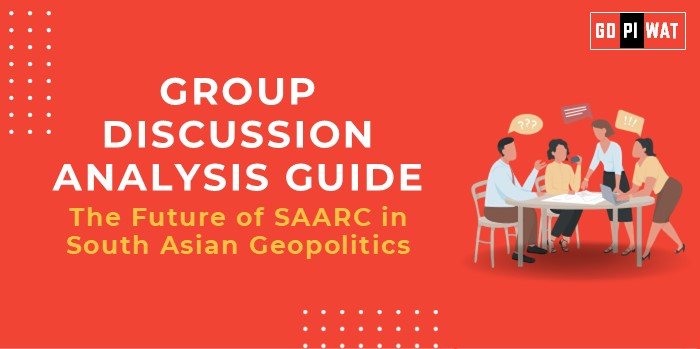📋 The Future of SAARC in South Asian Geopolitics: Group Discussion Analysis Guide
🌐 Introduction
The South Asian Association for Regional Cooperation (SAARC), established in 1985, was designed to foster collaboration and development among its eight member nations: Afghanistan, Bangladesh, Bhutan, India, Maldives, Nepal, Pakistan, and Sri Lanka. Representing a fifth of the global population, SAARC’s vision remains a critical topic of discourse amid evolving regional and global geopolitical challenges.
📊 Quick Facts & Key Statistics
- 🗓️ SAARC Inception: Founded in 1985 to promote regional collaboration.
- 👥 Population: Approximately 1.8 billion people, accounting for 24% of the world’s population.
- 📈 Economic Potential: ADB estimates show $85.1 billion trade potential under SAFTA (2008).
- 🔗 Trade Dependency: Intra-SAARC trade rose to $687 million in 2009, up from $14 million in 2006.
- ⚡ Connectivity Projects: SASEC proposed 200+ projects worth $120 billion to enhance trade and energy networks (2016).
🌍 Stakeholders and Their Roles
- 🌐 Member Nations: Act as primary drivers of policies and projects.
- 🏢 SAARC Secretariat: Coordinates initiatives and facilitates dialogue.
- 🌎 Observer Nations: Provide support for trade, development, and geopolitical stability.
- 💼 Private Sector: Invests in cross-border trade, connectivity, and innovation.
- 🏗️ Development Agencies (ADB, World Bank): Fund infrastructure and capacity-building programs.
🎯 Achievements and Challenges
🏆 Achievements:
- 📜 SAFTA Framework: Created a foundation for regional economic integration, with potential trade valued at $85.1 billion.
- 📈 Trade Growth: Intra-SAARC trade rose significantly from $14 million in 2006 to $687 million in 2009.
- 🚧 Connectivity Initiatives: SASEC identified transformative transport and energy projects.
- 🎨 Cultural Collaboration: Fostered educational exchanges and regional solidarity through scholarships and events.
⚠️ Challenges:
- ⚔️ Geopolitical Rivalries: Persistent tensions, particularly between India and Pakistan.
- 📊 Economic Disparities: Large gaps in GDP, development levels, and resource availability among member states.
- 📉 Low Trade Dependency: Intra-regional trade remains a fraction of total trade compared to other blocs like ASEAN.
- 🏗️ Infrastructure Gaps: Slow implementation of connectivity and energy projects due to funding and political hurdles.
🌍 Global Comparisons:
- 📊 ASEAN: Demonstrates the success of cohesive economic policies and strong trade networks.
- 🇪🇺 EU: Unified governance drives significant economic integration.
Case Study: SASEC Projects (2001–2016): Enabled energy trade and improved transport infrastructure in Bhutan, Nepal, and Bangladesh, showcasing regional collaboration potential.
📝 Effective Discussion Approaches
Opening Approaches:
- 📊 Data-driven Start: “SAARC nations represent 24% of the global population but struggle with intra-regional trade at a fraction of their total commerce.”
- ⚖️ Comparative Example: “While ASEAN drives 25% intra-regional trade, SAARC barely achieves 5%, underscoring its unrealized potential.”
Counter-Argument Handling:
- 📈 Use data (e.g., SAFTA trade growth) to show progress.
- 💡 Propose pragmatic reforms, such as issue-based cooperation.
📈 Strategic Analysis of Strengths & Weaknesses
Strengths:
- 🎭 Shared cultural and historical ties.
- 👥 Large workforce.
- 🌍 Vast natural resources.
Weaknesses:
- ⚔️ Geopolitical tensions.
- 📊 Economic disparities.
- 🏛️ Lack of effective governance.
Opportunities:
- 🔗 Harnessing trade agreements.
- 🏗️ Infrastructure investments.
- 🌎 Observer nation support.
Threats:
- 📉 Rising nationalism.
- 🌊 External pressures.
- ⛈️ Climate change vulnerabilities.
📚 Structured Arguments for Discussion
- 👍 Supporting Stance: “SAARC provides a robust framework to address shared challenges like climate change and trade facilitation through collaborative policies.”
- 👎 Opposing Stance: “Geopolitical conflicts and inefficiencies make SAARC’s goals unrealistic without significant reforms.”
- ⚖️ Balanced Perspective: “SAARC’s future lies in adopting flexible, issue-specific collaborations while strengthening governance structures.”
💼 Connecting with B-School Applications
Real-World Applications:
- 📈 Proposing regional energy-sharing models or designing strategies to improve SAARC trade dynamics.
Sample Questions:
- ❓ “What reforms can SAARC adopt to enhance its effectiveness?”
- ❓ “Compare SAARC’s performance with ASEAN in terms of economic integration.”


